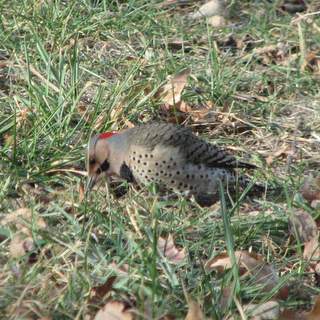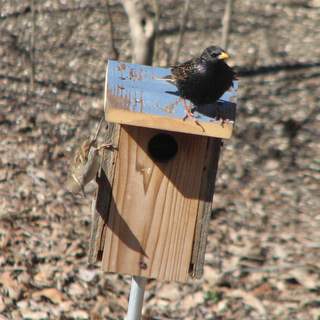I first created this site back in 1998 to document the wild plants that I encountered. But it has grown into a clearinghouse of information on landscaping, backyard birds, butterfly gardening, plant identification and making paper from plant fiber. After leaving Kansas, I thought of deleting the site. But realize it has a wealth of information that people rely upon.
Hosting the site is involved. I’d like to thank those who have donated to help defray the web site hosting fees. If you would like to contribute, please click the Donate button. Thank you.
Cavity Nesting Birds
About Cavity Nesters
Some tree dwelling birds build nests in the branches of trees and shrubs, while others nest in the cavities of trees.
Two kinds of cavity nesting birds will nest in your yard, primary and secondary.
- Primary cavity nesting birds build their houses by pecking and removing wood from a tree limb. Most primary cavity nesters are woodpeckers, who have the ability to excavate their own holes.
- Secondary cavity nesters generally use old holes of a primary cavity nesters like a previously excavated woodpecker hole. They also will nest in natural cavities that are often created when limbs break off trees. Bluebirds and chickadees are examples of secondary cavity nesting birds.
Some cavity nesting birds can be enticed to nest in man made nest boxes. Using nest boxes not only will help our native birds but it is rewarding for us as well. Beware that often nest boxes are usurped from native birds by either of two invasive birds: the house sparrow and the European starling.
Topics covered on this page include:- Attracting Cavity Nesters
- Primary Cavity Nesters
- Secondary Cavity Nesters
- Controlling House Sparrows & Starlings
Attracting Cavity Nesters with Nest Boxes
Erecting nest boxes (birdhouses) is one way to attract some cavity nesting birds.
The design of the nest box are important if you are to be successful attracting native birds. Each cavity nesting species of bird requires a specific box size, hole size, and mounting height.
The method used to mount them is as important as the design. They must be mounted to prevent predators from accessing the box.
Monitoring the nest box is important as there are many threats to nesting birds. By monitoring you can prevent problems that prevent them from nesting
Using nest box traps are important for controlling invasive species that will prevent native birds from nesting. Both the European Starling and the House Sparrow prevent our native birds from nesting.
Learn about these nest box topics.
Attracting Cavity Nesters with Homemade Suet
You will want to attract cavity nesting birds like woodpeckers by feeding them suet, especially in the winter time. Suet supplies the birds with a high energy food because it is mostly made from animal fat. The homemade suet I use is made from animal fat, peanut butter, oatmeal, corn meal, and wheat flour. It is the preferred food of all woodpecker species.
By attracting the birds to your yard with the homemade suet, you will more than likely get them to notice any nest boxes you have erected.
My Homemade Suet Recipe is easy to make and will definitely bring in the birds. Besides cavity nesting birds expect to see brown creepers and yellow-rumped warblers.
Attracting Cavity Nesters with Trees
Best native trees for cavity nesters
Native trees that are preferred by cavity nesters tend to have soft wood that is easily excavated. Cavity nesters don't just need the trees for nesting, but also for foraging for food for their hatchlings. Alien tree species do not support insects which the birds need to raise healthy young. Native tree species support hundreds of insect species that feed our native birds.
Favorite native trees for cavity nesters include
Having dead trees or dead tree limbs in your landscape is also important, especially for woodpeckers. Woodpeckers prefer making their home in the limbs of dead trees as well as foraging for insects that eat the dead wood. If a dead tree isn't a threat to your property or neighbor's property, consider leaving it for woodpeckers and other wildlife.
Primary Cavity Nesters in Kansas
 Northern flicker feeding on the ground
Northern flicker feeding on the groundPrimary cavity nesting birds make their own homes by excavating holes in trees. They generally will not adopt nest boxes for nesting. For a better chance to get them to nest in nest boxes, fill the box with wood chips. The woodpeckers will clear out the chips as they would excavate a hole.
A better way to attract them is to leave dead trees in your landscape. Dead limbs in live trees will be used by them as well.
Primary Cavity Nesters
- Downy woodpecker (readily roosts in nest boxes)
- Hairy woodpecker
- Red-bellied woodpecker (sometimes will nest in nest boxes)
- Red-headed Woodpecker (sometimes will nest in nest boxes)
- Northern Flicker (frequently will nest in nest boxes)
- Pileated woodpecker
Secondary Cavity Nesters in Kansas
There are many secondary cavity nesting birds found in Kansas. Many of these will adapt to nest boxes, if properly constructed and placed.
Native Small Secondary Cavity Nesters
- House Wren
- Black-capped Chickadee
- Carolina Wren
- White-breasted Nuthatch
- Tufted Titmouse
- Eastern Bluebird
- Tree Swallow
- Purple Martin
- Great Crested Flycatcher
Native Large Secondary Cavity Nesters
These all require a 3" hole or larger
- American kestrel
- Eastern screech owl
- Wood duck
Introduced Secondary Cavity Nesters
Both of these species compete with our native cavity nesting birds. Do not allow either to nest.
If they attempt to nest in a nest box, they can be trapped using a Nest Box Trap.
Controlling European Starlings and House Sparrows
 European Starling & House Sparrow competing for the same house
European Starling & House Sparrow competing for the same houseThe European starling and house sparrow are aggressive introduced species that compete with native cavity nesting birds. They will harass and even attack and kill native cavity nesters, in an effort to nest. Both the starling and the house sparrow start adopting nesting sites well before our native birds start searching out nesting locations. Their populations are so large that our native cavity nesters don't have much of a chance to compete with them.
European Starlings can be prevented from using nest boxes (bird houses) meant for bluebirds by the 1 1/2" entrance hole. For larger sized holes, using a nest box trap is the only solution. Learn more about European Starling Control.
House Sparrows cannot be prevented from using nest boxes (bird houses) meant for bluebirds as they can enter a 1 1/2" hole. Using a nest box trap can be used to prevent them from nesting. Learn more about House Sparrow Control.
Only nesboxes made for House Wrens and Chickadees can be made to prevent House Sparrows from entering. These species can enter a 1 1/8" hole.
One productive method for controlling both of these species is to use a Nest Box Trap.
DISCLAIMER: This page contains affiliate links in the right hand panel, which means that if you click on one of the product links, I’ll receive a small commission. This helps support my website and allows me to continue to add new content. Thank you for the support!
